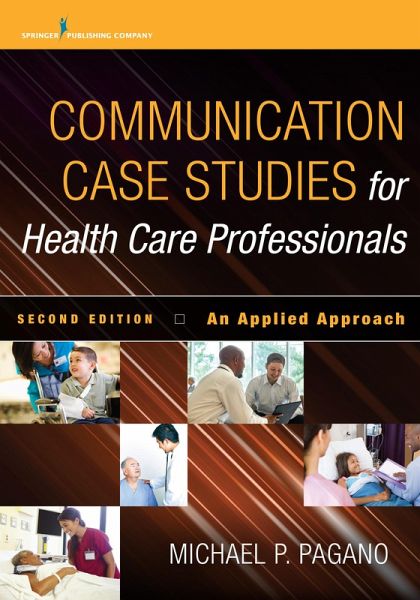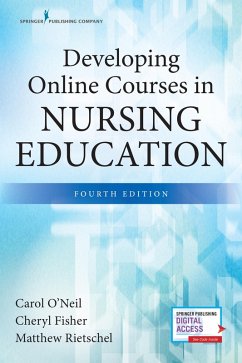
Communication Case Studies for Health Care Professionals, Second Edition (eBook, ePUB)
An Applied Approach

PAYBACK Punkte
30 °P sammeln!
PRAISE FOR THE FIRST EDITION:"Öallows students and faculty to explore real-life health communication behaviors through role-playing, interactive exercises, and examplesÖeasily adapted for use in many situations, sensitivity and diversity trainingÖvery worthwhile book for every medical faculty member working to instill professionalismÖin students."óVincent Carr, DO, MSA, FACC, FACP, Uniformed Services University of the Health SciencesThe importance of good communication between health professionals and patients has been well documented. Not only does it foster patient satisfaction, it can ...
PRAISE FOR THE FIRST EDITION:
"Öallows students and faculty to explore real-life health communication behaviors through role-playing, interactive exercises, and examplesÖeasily adapted for use in many situations, sensitivity and diversity trainingÖvery worthwhile book for every medical faculty member working to instill professionalismÖin students."
óVincent Carr, DO, MSA, FACC, FACP, Uniformed Services University of the Health Sciences
The importance of good communication between health professionals and patients has been well documented. Not only does it foster patient satisfaction, it can have a profound effect on health outcomes. This casebook/workbook helps students, faculty, and health care providers to assess and practice key interpersonal and health communication skills. It presents 45 communication scenarios for students to critique and rewrite in order to enhance the interpersonal relationships of participants. The second edition builds on the first with the addition of 11 new cases and theoretical discussions of interpersonal, gender, intercultural, organizational, and media communication. Additionally, the new edition analyzes each scenario in detail to facilitate broader use by an interprofessional team and expand awareness of the specific skills needed by each health care professional. The new Take-Away Considerations feature at the end of each case study reinforces an understanding of the elements of effective communication.
With an eye to time management, each chapter includes effective and ineffective examples of interpersonal communication and interpersonal relationship building. Cases follow the same format including theoretical underpinnings of a particular skill or set of communication skills, an overview of key topics, initial interaction (for role play or analysis), discussion questions (with space for answers), interactive activities and an alternate interaction highlighting more effective communication behaviors, follow-up discussion, key points, and Take-Away Considerations. Scenarios can be used for role play and follow-up discussion in the classroom, for small group work, or individually, as well as in the simulation center and for interprofessional education courses.
NEW TO THE SECOND EDITION:
"Öallows students and faculty to explore real-life health communication behaviors through role-playing, interactive exercises, and examplesÖeasily adapted for use in many situations, sensitivity and diversity trainingÖvery worthwhile book for every medical faculty member working to instill professionalismÖin students."
óVincent Carr, DO, MSA, FACC, FACP, Uniformed Services University of the Health Sciences
The importance of good communication between health professionals and patients has been well documented. Not only does it foster patient satisfaction, it can have a profound effect on health outcomes. This casebook/workbook helps students, faculty, and health care providers to assess and practice key interpersonal and health communication skills. It presents 45 communication scenarios for students to critique and rewrite in order to enhance the interpersonal relationships of participants. The second edition builds on the first with the addition of 11 new cases and theoretical discussions of interpersonal, gender, intercultural, organizational, and media communication. Additionally, the new edition analyzes each scenario in detail to facilitate broader use by an interprofessional team and expand awareness of the specific skills needed by each health care professional. The new Take-Away Considerations feature at the end of each case study reinforces an understanding of the elements of effective communication.
With an eye to time management, each chapter includes effective and ineffective examples of interpersonal communication and interpersonal relationship building. Cases follow the same format including theoretical underpinnings of a particular skill or set of communication skills, an overview of key topics, initial interaction (for role play or analysis), discussion questions (with space for answers), interactive activities and an alternate interaction highlighting more effective communication behaviors, follow-up discussion, key points, and Take-Away Considerations. Scenarios can be used for role play and follow-up discussion in the classroom, for small group work, or individually, as well as in the simulation center and for interprofessional education courses.
NEW TO THE SECOND EDITION:
- Includes theoretical introductions to interpersonal, gender, intercultural, organizational, and media communication
- Presents 11 new case studies
- Provides an introduction for each case study
- Describes the application of communication theory for more effective use in the classroom, simulation center, or professional setting
- Features Take-Away Considerations at the end of each case
Dieser Download kann aus rechtlichen Gründen nur mit Rechnungsadresse in A, D ausgeliefert werden.













